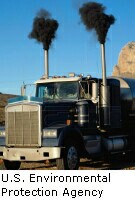
WEDNESDAY, April 27 (HealthDay News) — About 154 million Americans — or more than half the U.S. population — live in areas where the air is so polluted that it is often dangerous to breathe, a new report says.
Residents of Honolulu and Santa Fe-Espanola, N.M., on the other hand, are in luck: Those two cities had air that is among the country’s cleanest — and they were the only two in the nation that had no days in which smog and soot levels reached unhealthy ranges.
In contrast, residents of California, which is famed for its healthful lifestyle, are breathing some of the worst air.
California cities topped the list of U.S. cities with the worst air pollution, according to “State of the Air 2011,” the American Lung Association’s annual report on air quality, which was released April 27.
And about 48 percent of U.S. residents live in counties where smog (ozone) is too high, 20 percent live in areas where there are too many short-term spikes in pollution and 6 percent live in areas with harmful year-round soot (particle pollution).
About 17 million Americans live in areas afflicted by all three air pollution hazards.
This worries scientists since research suggests air pollution threatens human health — and not just the lungs.
On days in which smog levels spike, there’s an increase in hospital admissions for respiratory illnesses, heart attacks and stroke in the two or three days following it, said Michael Jerrett, a professor of environmental health sciences at University of California, Berkeley’s School of Public Health.
Besides posing both long-term and short-term risks, pollution can contribute to low birth weights, diabetes, cardiovascular disease, heart attack, stroke and, ultimately, shorter life spans, he warned.
This is due, in part, to insidious changes caused by chronic exposure to pollution. According to Dr. Norman Edelman, chief medical officer of the American Lung Association, small particles of pollution can lodge deep in the lungs, triggering an inflammatory process that, over time, can spread elsewhere in the body and damage blood vessels and the heart.
The report found that the cities with the worst air include: Los Angeles-Long Beach-Riverside; Bakersfield-Delano; Visalia-Porterville; Fresno-Madera; Sacramento-Arden-Arcade-Yuba City (Calif.-Nev.); Hanford-Corcoran; San Diego-Carlsbad-San Marcos; and Merced — all of which are in California with the exception of one county just across the border in Nevada.
Rounding out the top 10 list for smog is Houston-Baytown-Huntsville, Texas and Charlotte-Gastonia-Salisbury, N.C.-S.C.
Many of those same places show up on the top 10 list for year-round soot. That list includes: Bakersfield-Delano; Los Angeles-Long Beach-Riverside; Phoenix-Mesa-Glendale, Ariz.; Visalia-Porterville; Hanford-Corcoran; Fresno-Madera; Pittsburgh-New Castle, Pa.; Birmingham-Hoover-Cullman, Ala.; Cincinnati-Middletown-Wilmington, Ohio-Ky.-Ind.; and Louisville-Jefferson County-Elizabethtown-Scottsburg, Ky.-Ind.
But there is some good news, said Janice Nolen, director of national policy for the American Lung Association. The majority of cities with polluted air have actually improved. Nolen credited the Clean Air Act, which, since its passage more than 40 years ago, has forced car and diesel truck manufacturers and coal-fired power plants, among others, to reduce emissions.
“The ‘State of the Air 2011’ finds the Clean Air Act is working. All metro areas on the list of the 25 cities most polluted by ozone showed improvement over the previous report, and 15 of those cities experienced their best year yet,” Nolen said. “All but two of the 25 cities most polluted with year-round particle pollution improved over last year’s report.”
The U.S. Environmental Protection Agency (EPA) estimates that the Clean Air Act saved 160,000 lives in 2010 alone.
“We are trying to remind folks that the Clean Air Act has saved hundreds of thousands of lives,” Nolen said. “Without the clean up, we would have a lot more pollution and a lot more disease and dying. We are very concerned about efforts to roll it back.”
Although some attack the Clean Air Act as unnecessary, experts disagree. Jerrett explained that the research linking pollution to death and disease comes from animal experiments, human volunteers who go into pollution chambers where physiologic response is measured, changes in cell cultures when cells are exposed to pollution “and quite a few epidemiological studies.”
“The body of evidence is large enough that if it’s not fully evidence of causality, it’s certainly strongly suggestive that pollution affects health in many adverse ways,” Jerrett added.
Why does California, with its history of tough regulation, have such a pollution problem? It’s a combination of factors, according to Jerrett. The state has lots of sources of emissions, including burgeoning car and truck traffic, major ports, oil refineries, wood and agricultural burning, and residential heating and cooling.
In areas such as Los Angeles, prevailing wind patterns and mountain ranges trap polluted air that’s then baked in the sunshine, leading to the formation of smog.
The “State of the Air 2011” report uses state and local data reported to the EPA in 2007 to 2009. Measurements include ozone, year-round particle pollution and short-term pollution spikes.
More information
The State of the Air 2011 report is available here.

